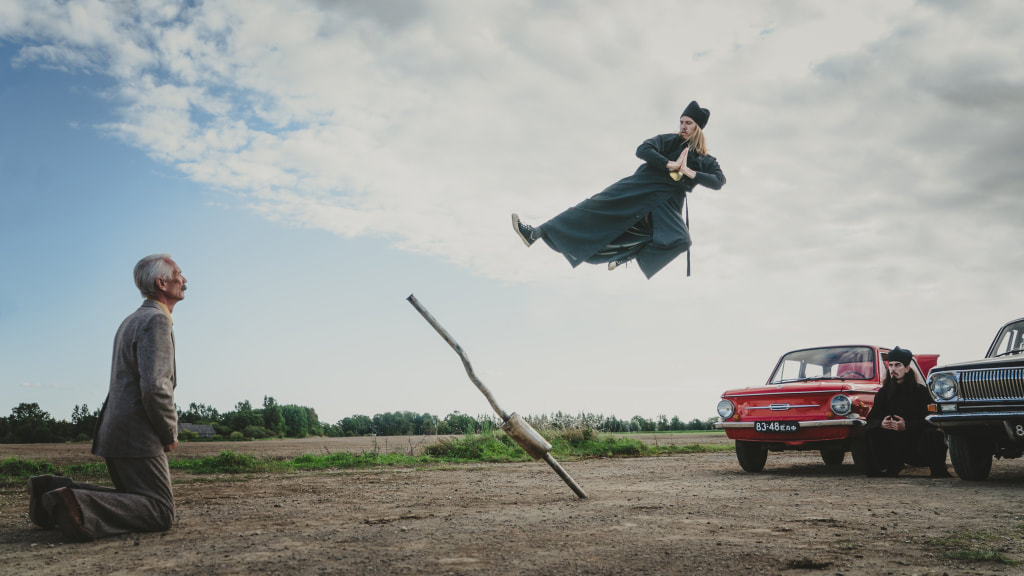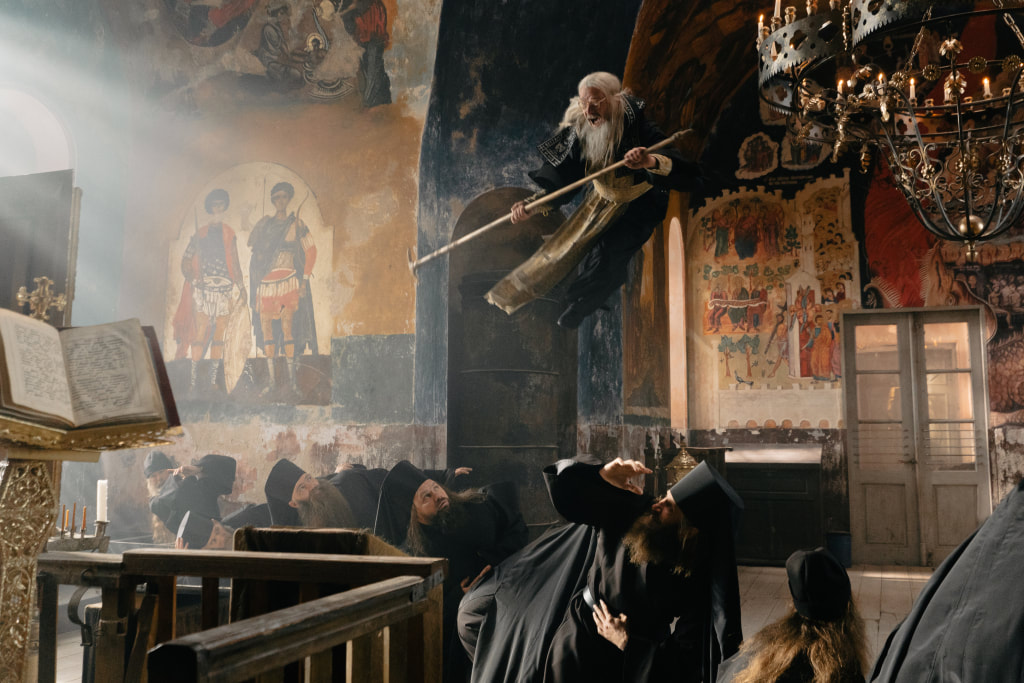|
Review by Daniel Lima There was a time when the prospect of a silly, lazy pastiche of old kung fu movies that attempted to coast entirely on charm and good vibes was catnip to me, regardless of how well they emulated those films or whether they had a clear voice of their own. Now, the moment I see fake film grain and scratches added in post over digital footage, the blood in my veins freezes up as I prepare for a test of endurance. The Invisible Fight — the latest in this ignoble subgenre — is no better than any of the films that preceded it. In some crucial ways, it is much worse. Ursel Tilk stars as a Russian soldier at a military outpost who is the sole survivor of an attack by high-flying, leather-clad, metalhead warriors. Spurned on by this experience, he becomes a monk at the local Eastern Orthodox monastery with the intention of becoming a “badass at black metal kung fu.” Though he takes to his duties well, jealous brothers, disdainful mothers, and a vexing love interest all vying to pull him away from the spiritual journey he has embarked on. The first scene is the attack by a small group of warriors, blaring Black Sabbath’s music from their boomboxes. It is immediately evident that this film will only superficially borrow the aesthetics of the ones it is aping, amounting to the aforementioned post effects plus the occasional dramatic zoom. It’s not a bad-looking movie, with some interiors displaying genuinely striking lighting, but it is very conventional and in keeping with a modern independent comedy. It fails to either evoke the particular feel of classic martial arts cinema or establish a particular feel of its own. The basic structure is, at first glance, not dissimilar to any number of films about brash young students who labor to join the ranks of Shaolin monks. While they at first join because of their status as legendary martial artists, the tough training instills in them the value and philosophy of the ascetics, to the point that they become genuine converts. They are constantly faced with temptation, but their commitment allows them to persevere. Importantly, however, it is an actual challenge for the heroes of those Chinese (well, typically Hong Kong) films. Tilk’s character is shown to immediately understand all the lessons being impressed upon him, and his many transgressions are all immediately forgiven due to the ease with which he accomplishes his tasks. It could be argued that this allows for the development of the character played by Kaarel Pagga, a pious monk incredibly jealous of Tilk’s success and nonconformity. However, that means most of the runtime is spent with a protagonist who never has to grow or change.
To make matters worse, this movie is nearly two full hours, when most of its inspirations would barely hit an hour and forty minutes. This is the result of a very shaggy narrative, filled with superfluous fluff that never amounts to anything. An encounter with Soviet officials seems like a satiric attack on their policies towards religion, but that is not elaborated on. Many scenes are spent with the women who live in the monastery, but these are ill-defined. There simply isn’t enough here to support such a long runtime, so the film quickly outstays its welcome. One would hope that, if nothing else, the action would capture at least a bit of the spark of people like Lau Kar-Leung, that classic choreography that was so expressive and distinct. That does not happen. These actors are not martial artists or stunt people, nor is the director, and that is made clear by how stiff and immobile all the fight scenes are. There are some inspired beats throughout the action design, mostly involving wirework, but it does have the feel of a high school production where the primary concerns are safety, then comedy, and then excitement at a distant third. This naturally begs the question: “Is it funny?” After all, this movie is more in conversation with the likes of Kung Fu Hustle and Kung Pow: Enter the Fist than Shaolin Temple itself. How does it hold up to the standard of post-modern martial arts comedies? Obviously, this is the most subjective quality of any film. All I can say is that I personally found the film so deeply and abrasively unfunny that it feels like a moral failing on the part of the filmmakers. Like so many other small-scale comedies, director Rainer Sarnet appears so tickled by the idea that he is transposing the classic Shaolin training narrative to his native land and blending it with incongruities like metal music that he forgets to make actual jokes. Most of the comedy is physical, rooted in the spirited performance of Tilk, but he can only go so far when the material is so dusty and hack. Two monks attempting to stop their speeding vehicle give the appearance of performing oral sex; Tilk gets a tour of the abbey in undercranked footage, and he trips on a garden hose; Tilk dumps a bunch of pepper into his food and doesn’t like the taste. That these are some of the comedic highlights of a two-hour film makes most of that runtime agonizing. The most interesting and distinct aspect of The Invisible Fight is the one most frustratingly never fully explored. The Hong Kong films that so mythologized the Shaolin monastery reflected both the spiritual tenets of Chinese martial arts and the contemporary relationship Hong Kong had with mainland China (or, more specifically, the CCP). In setting this film in the Eastern Orthodox Church in the Soviet Union, there are ample opportunities for an exploration of the religion and traditions of the Orthodox Church and the Church’s relationship with a militantly nonreligious government. This thread is not picked up; instead, it simply uses empty platitudes while going through the motions and mimicking the plots of those action classics without recognizing what gave those films that staying power. This, more than anything, is its greatest failure. The Invisible Fight is now in theaters. Rating: 1/5
0 Comments
Leave a Reply. |
Archives
July 2024
Authors
All
|
|
|
disappointment media
Dedicated to unique and diverse perspectives on cinema! |


